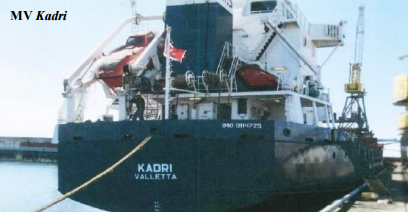Transport Malta has issued a safety investigation report occasioned by the incident of a fatal injury to a crew member of MV Kadri at Tallinn Shipyard.
The purpose of the marine safety investigation is to determine the circumstances and safety factors of the accident as a basis for making recommendations, and to prevent further marine casualties or incidents from occurring in the future.
On 19 May 2015, an able seaman on board the Maltese registered cargo vessel Kadri was found fatally injured on the quay. The vessel was alongside a layby berth undergoing repairs at a shipyard in Tallinn, Estonia.
At the time of the accident the able seaman was reportedly standing on the cargo hatch cover, checking the hatch cleats prior to repairs by the shipyard. He was alone and no one witnessed the events leading to his fall. However, it was not excluded that he may have stumbled, lost his footing and fell over. A shipyard employee found him on the quay, unresponsive and bleeding from the head. He was administered first aid and transported to the local hospital for further treatment. However, he died the following morning as a result of his injuries and hypovolemic shock. On the basis of the safety actions communicated to the MSIU, no recommendations were issued to the Company.
Conclusions
The safety investigation concluded that the serious injuries suffered by the able seaman were comparable with that of a fall from a height. The safety investigation did not
exclude the possibility of the able seaman standing on the ship’s rails in order to reach for the cleats. It was considered probable that the able seaman’s movements, whether standing near the edge of the hatch cover or on the ship’s rails, faltered, lost his footing and fell down on the hard surface of the quay. The able seaman was not wearing a safety harness with a fall arrestor device attached to the safety line. The risk of falling overboard had been accepted by the crew member. It was not excluded that the risk perception of the crew member may have biased the intrinsic risk within the system, affecting the accuracy of his risk appraisal. The crew member may have either underestimated the actual risk and overestimated his personal capacity. There was no evidence of an applied ‘risk management culture’, which focussed on system safety with the application of various engineering techniques to identify hazards and, if possible, objectively quantifies risks.
Further information may be found by reading the saferty investigation report below.
Source & Image credit:Transport Malta































































